Medium Format Desert Photography of Capitol Reef National Park
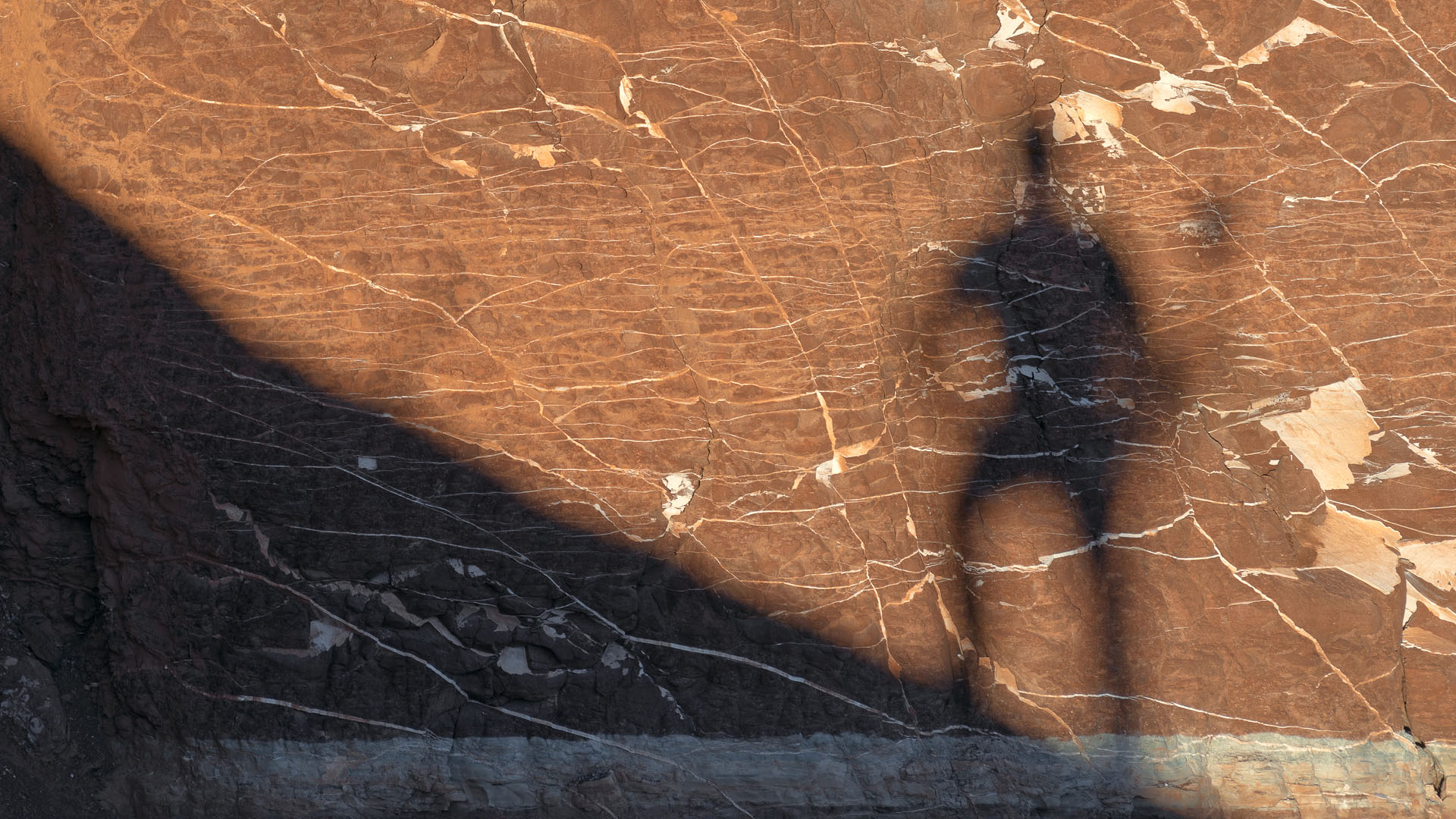
Capitol Reef National Park and its surrounding areas offer a contrast of landscapes, from sandstone cliffs to fall foliage, and this series of images explores both the vistas and intimate details of Utah's canyon country, captured using two distinct medium format camera systems: a technical camera setup combining an Arca-Swiss Rm3di with a Hasselblad CFV 100C digital back, and the Fujifilm GFX 100 II medium format camera.
While both systems share the same 100mp medium format sensor, they serve different purposes for me. The technical camera, which I typically used for landscape photography, encourages a slower, more deliberate approach to image-making. The GFX system, which I primarily used for commercial work, offers modern automation that better integrates with architectural and commercial photography practices. On this trip though, I brought both.
This collection was created during Hunter Page's Capitol Reef & Utah Badlands photography workshop, where the emphasis was on crafting compelling imagery throughout the entire day, not just during traditional golden hours. The workshop's approach centered on finding simple, balanced compositions within the desert's complex landscape while utilizing the unique characteristics of reflective canyon light.
The technical challenges of this project were considerable, with many images requiring exposures of 20-30 seconds at ISO 320 to 800 and f/11. In these extremely low light conditions, each system presented distinct challenges. The Hasselblad CFV 100C's screen was unusable. However, the Arca Swiss's precise helical focusing and my pre-marked infinity settings for each lens allowed shooting when it was too dark for the screen to display the scene in front of me.
Low light conditions presented a significant challenge with the GFX system's longer lenses as well. Both the GF 500mm and GF 100-200mm rendered the viewfinder and screen nearly unusable for focusing in dim light, though interestingly, the GF 32-64mm lens maintained normal brightness levels. While other workshop participants with Canon and Nikon cameras had no such difficulties, I was left wondering: is this a characteristic limitation of medium format gear, or simply user error? Further testing is needed to determine the cause.
The following sections present these photographs organized by camera system and lens, showcasing how different optical tools can shape the way we see and interpret the landscape. Throughout the workshop, my compositional goal was to emphasize simplicity and balance, which is especially impactful in this desert landscape.
The locations photographed include Capitol Reef National Park, Factory Butte near Hanksville, South Cainville Mesa, and surrounding areas. Each location presented different opportunities for both grand scale and intimate landscape photographs.
Images made with the Fujifilm GFX 100 II
The GFX system's modern capabilities allow me to work more intuitively with the landscape. The ability to quickly change lenses or zoom with the GFX zoom lenses helps me explore different focal lengths and rough compositions. Then the camera's excellent handling means I can freely work handheld - adjusting height and moving around the scene until I find exactly the right perspective. Once I've found the right composition, I set up on a tripod for the final capture. These benefits are particularly helpful during the fleeting moments of twilight, when the desert's colors shift dramatically with each passing minute.
Fujinon GF32-64mm F4 R LM WR Lens
The GF32-64mm F4 proved invaluable for photographing wider landscapes throughout the workshop. The Castle at Dusk and Factory Butte in twilight are good examples of the lens's ability to include both foreground elements and distant features to help create layered compositions.
1. The Castle at Dusk
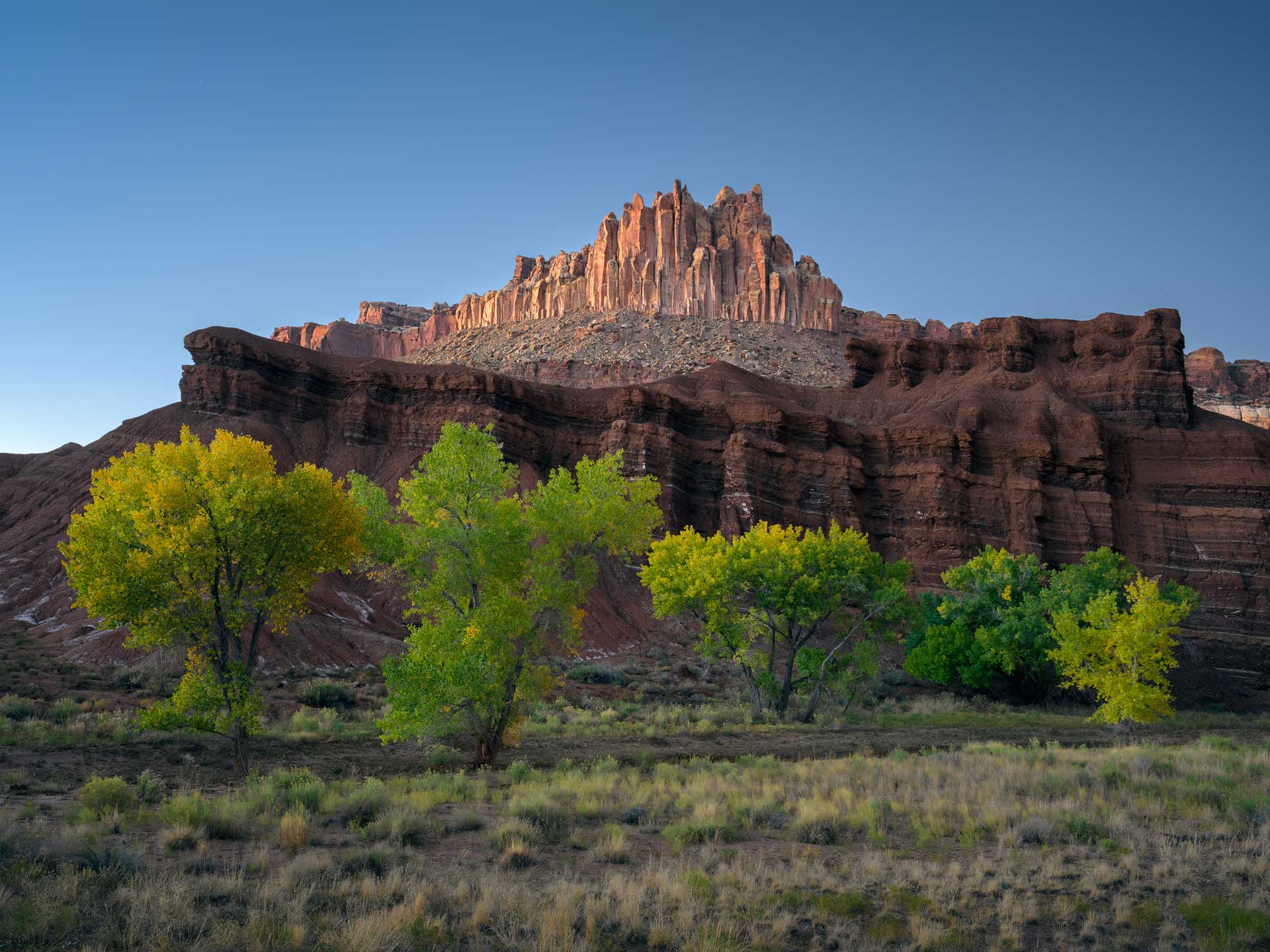
My exploration of this scene began about 100 yards from the final camera position - the GFX's handling allowing me to freely work in the diminishing twilight until I found this precise composition. Layered elements build from foreground to background, with desert grasses providing a textural foundation, leading to a row of autumn cottonwood trees in the middle ground. The trees are deliberately positioned to be framed entirely by the landscape, avoiding any overlap with the clear blue sky above.
At the highest point of the composition, Castle formation sits against the deepening blue sky. The diffused light conditions of twilight reveal subtle luminosity throughout the scene - from the gentle glow in the desert grasses to the delicate highlighting of the rock formations. While this image captures the last light of day, the next image explores similar exposure techniques in the pre-dawn twilight at Factory Butte.
2. Factory Butte at Twilight
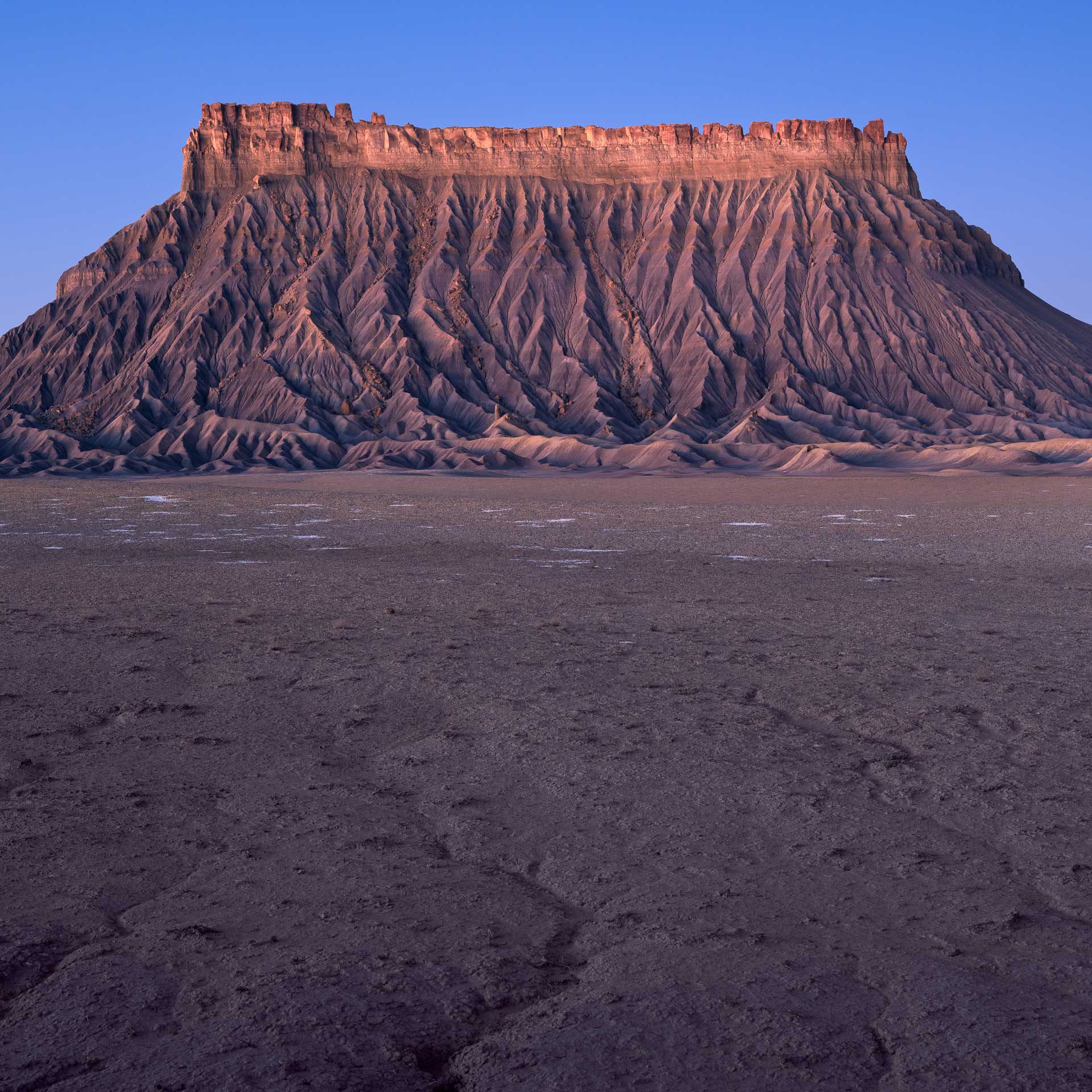
Rising dramatically from the desert floor, Factory Butte fills most of the square frame, with its eroded flanks creating a pattern of ridges and gullies. I chose the square format to emphasize the monumental presence of the butte, allowing its dramatic form to dominate the composition.
Pre-dawn light bathes the scene in subtle purple hues, while the upper rim catches slightly warmer tones against the twilight sky. Leading lines formed by desiccation cracks in the desert floor draw the eye toward the butte. Through a 10-second exposure in low light conditions, subtle textures and tones emerge in both the cracked earth and the butte's erosion patterns. The next image moves in closer with a telephoto lens to explore the intricate details of the butte's eroded surface.
Fujinon GF100-200mm F5.6 R LM OIS WR Lens
This lens was used for both distant and close-up compositions. For Factory Butte's erosion patterns, it allowed for tighter, more abstract framing that emphasizes geometric patterns and subtle color variations. The lens also proved capable in close-up work, as shown in the mud crack image where it revealed textures and reflected light on the desert floor.
3. Erosion Patterns at Factory Butte
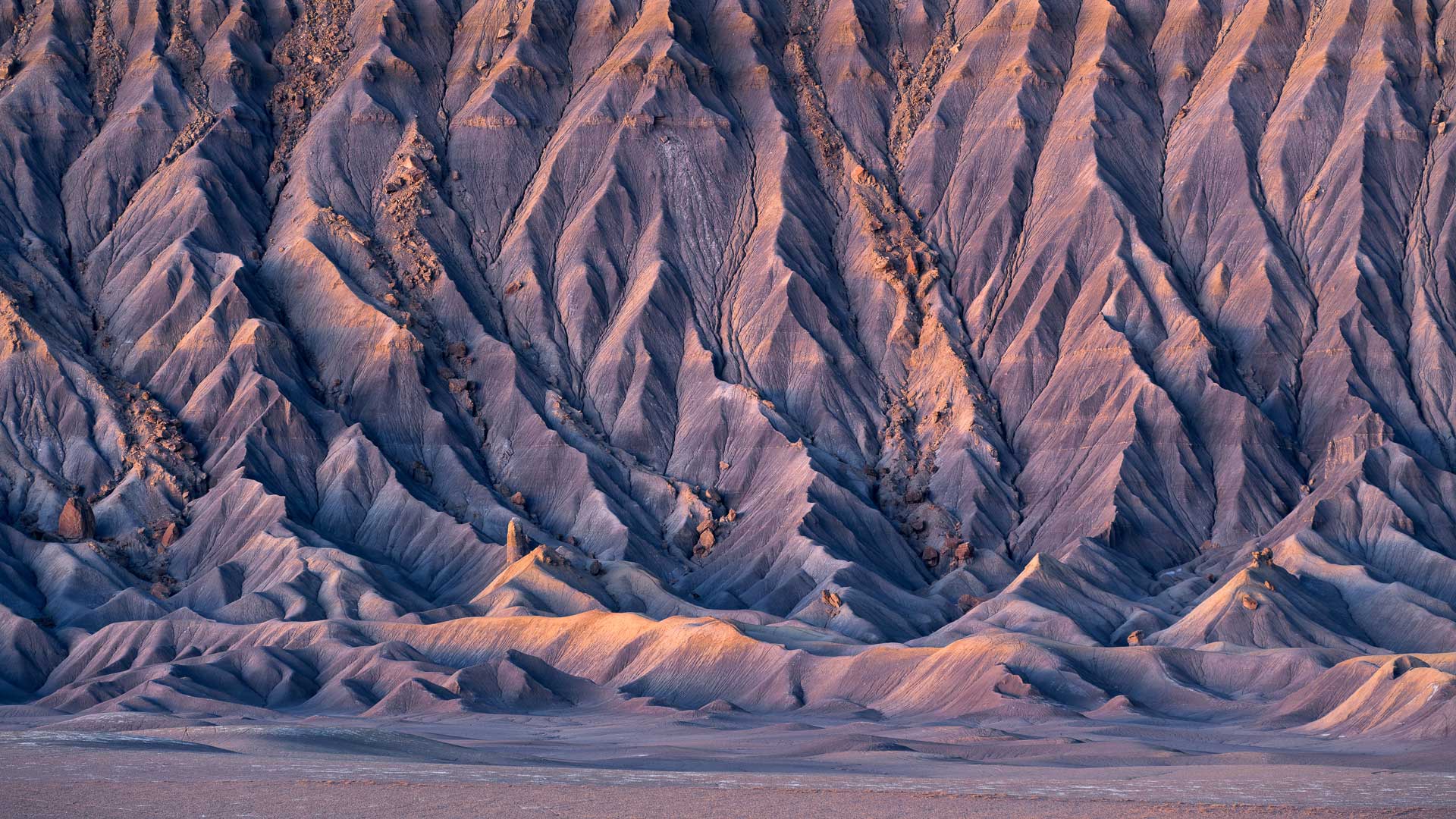
Using a telephoto perspective transforms Factory Butte's geological features into an abstract composition. The soft illumination of early morning reveals diagonal lines that create rhythmic patterns across the frame. The main face emerges in deep violet tones, while the sculpted ridgelines catch the first hints of sunlight in amber hues. A gentler slope in the lower portion provides a visual foundation, its smoother texture contrasting with the dramatic erosion patterns above.
The 16:9 format embraces the horizontal flow of these patterns across the face of the butte. Moving from these large-scale erosion patterns, the next image explores the geometric patterns created by drying mud in the desert floor.
4. Desert Patterns in Blue
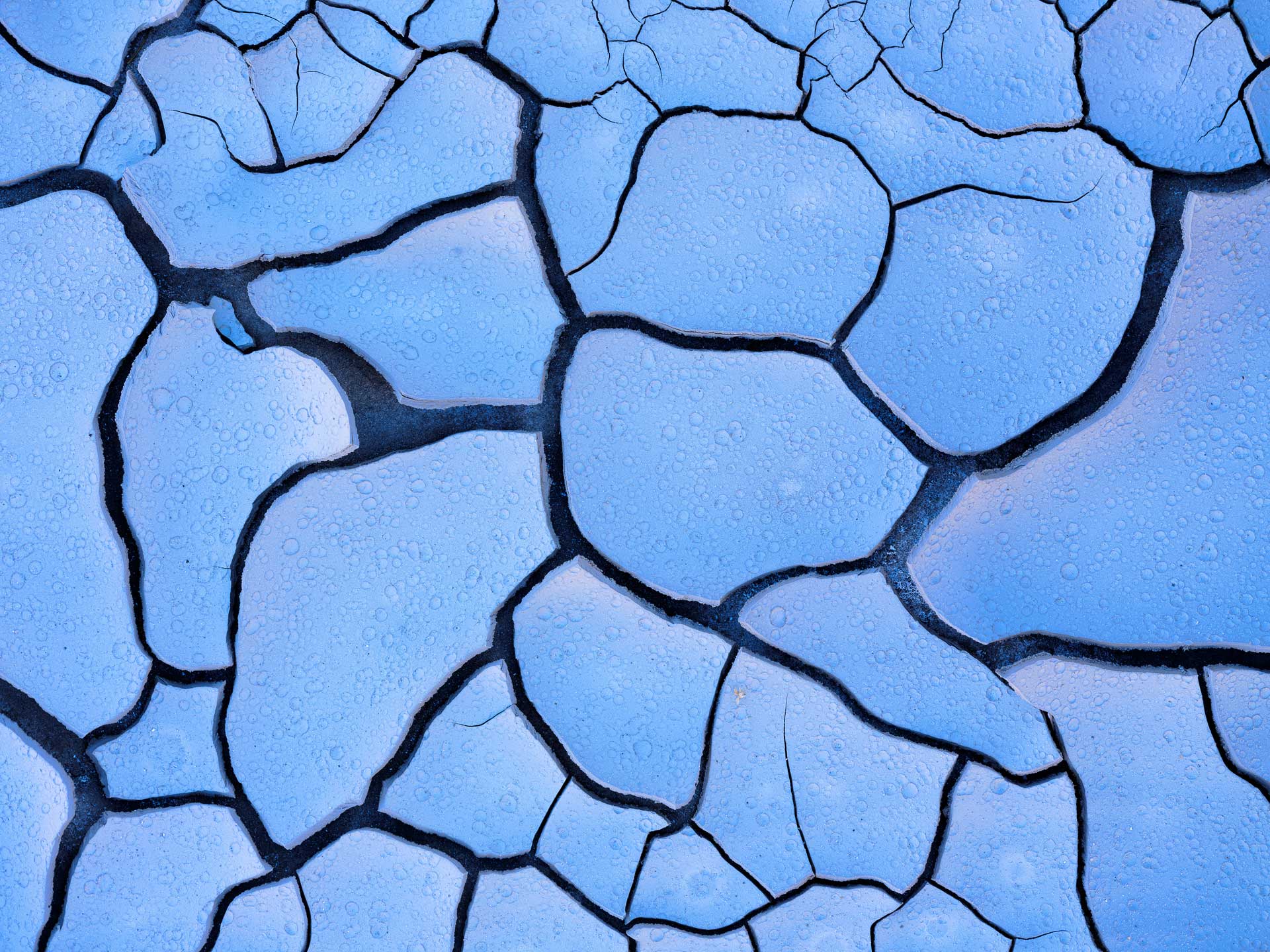
Through the telephoto lens, these mud cracks become a more abstract interpretation of the desert environment. By isolating these easily overlooked patterns, I aimed to transform them into form and texture, where the interplay of light and shadow reveals the desert's hidden geometries.
Light reflecting off nearby canyon walls illuminates the scene softly, creating dramatic contrast between deep shadows in the fissures and the illuminated surfaces of the mud plates. A combination of Velvia color profile and 5000°K white balance brings out the rich blue tones of the sky reflecting on the surface of the mud cracks throughout the image. Adding intrigue to the composition are the impressions left behind by long-evaporated raindrops, an unexpected texture in this arid setting. From these geometric patterns shaped by the desert environment, the next series of images explores organic forms revealed by reflected canyon light.
Images Made with the Arca-Swiss Rm3di and Hasselblad CFV 100C
Working with the technical camera system creates a meditative space where I can fully immerse myself in the scene before me. The precise movements and deliberate setup process naturally lead to more contemplative compositions. This approach proved particularly valuable when working with compositions that require subtle adjustments in camera position which can dramatically affect how the light reveals texture and form in the landscape.
Schneider-Kreuznach Apo-Digitar 5.6/120 asph. Lens
The lens's large image circle provides flexibility in composition, particularly useful in the backlit cottonwood image where 20mm of vertical shift with the back in horizontal orientation helps frame the tree against the canyon wall. Sharp throughout its 150mm image circle, it performs equally well for distant subjects and close-up work, as demonstrated in both the cottonwood and canyon wall scene and the fallen leaves image.
5. Cottonwood and Canyon Wall
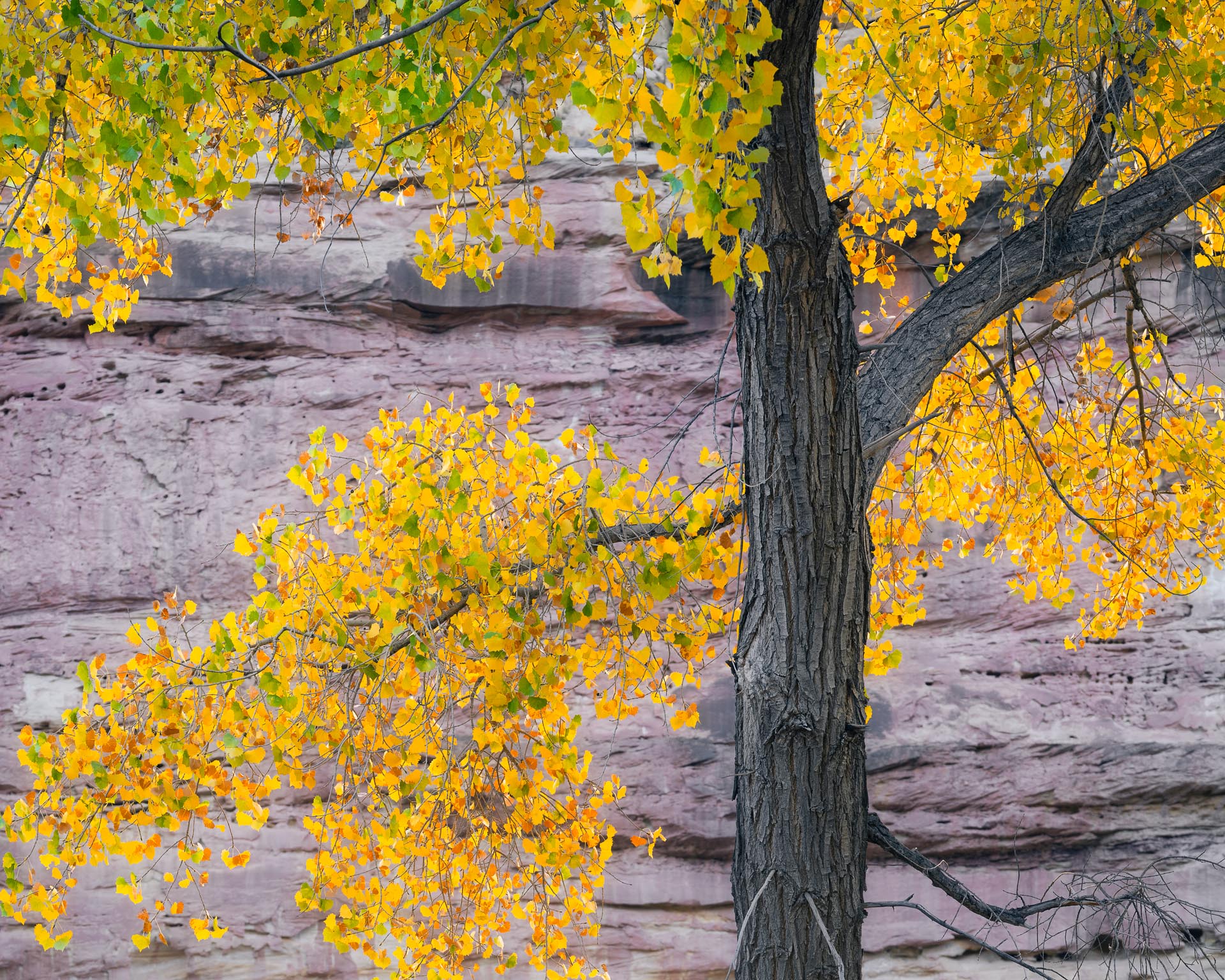
Along the Fremont River in Capitol Reef National Park, this intimate landscape balances leaves backlit by reflected light, creating a subtle yellow glow, contrasting with the cooler tones of the tree trunk, branches, and shaded canyon wall.
The final composition required careful fine-tuning of the Arca-Swiss Rm3di's shift movements to position the trunk as a natural division in the frame. From this anchoring element, branches extend gracefully across the image, creating a dynamic interplay with the texture of the canyon wall. While this image showcases the subtle illumination of reflected light, the next image demonstrates how direct backlighting creates stark contrast.
6. Backlit Cottonwood Study
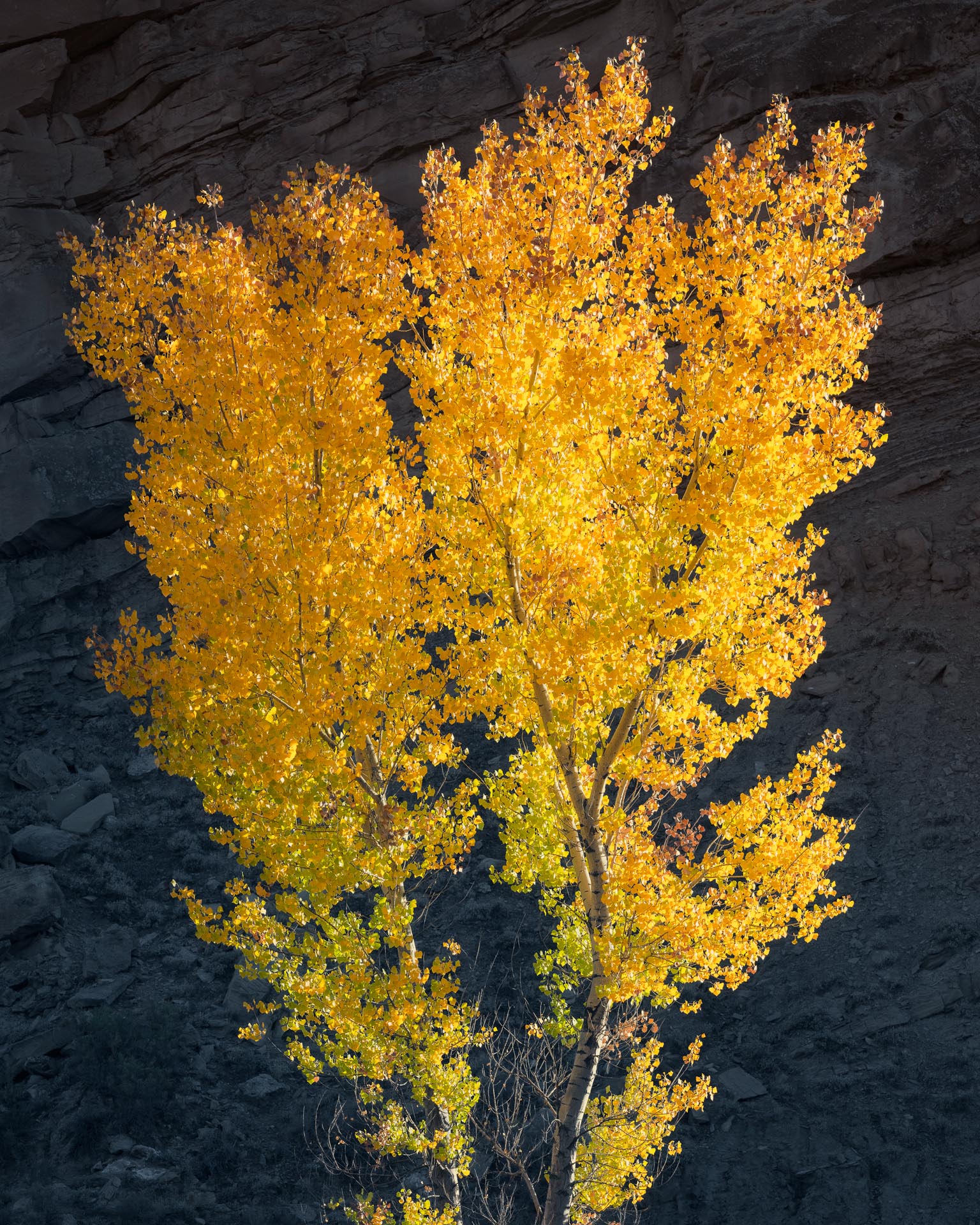
The camera's vertical shift movement, raised 20mm, helps frame this cottonwood tree dramatically against the canyon wall along the Fremont River. Direct backlighting creates stark contrast between the illuminated foliage and the shadowed background, demonstrating a different quality of light than the gentle glow of reflected light in the previous image.
Color gradients play through both elements of the composition - the canyon wall transitions from cool to warm tones, mirrored by the tree's progression from green at its base through brilliant yellow to red in its crown. From this study of a whole tree in direct light, the next image moves closer to examine fallen leaves in the soft illumination of reflected canyon light.
7. Fallen Cottonwood Leaves

Using a rear extension tube with the 120mm lens brings these carefully arranged cottonwood leaves into close focus. While the vast majority of my images capture the landscape as found, here the fallen leaves are arranged deliberately, creating an intimate still life that speaks to both the season's beauty and its impermanence.
Reflected canyon light illuminates intricate details - leaf veins, serrated edges, and variations in autumn colors. The next section continues exploring reflected light's revealing qualities, but from a greater distance using the Nikkor M 200mm lens.
Nikkor M 200mm f/8 S Lens
Though originally designed for 4x5 large format cameras, this lens delivers exceptional resolving power that rivals modern digital optics. Its Copal 0 shutter size sets it apart from other large format telephotos, making it an ideal digital companion given its compact size and light weight. In these three scenes, its telephoto compression reveals different aspects of the landscape: layered autumn foliage at South Cainville Mesa, abstract patterns in eroded hills, and the interplay between the Chinle Formation and valley cottonwoods.
8. Autumn Palette at South Cainville Mesa

Below South Cainville Mesa, I used the telephoto perspective to compress a grove of trees into a tapestry of autumn colors. My goal was to abstract the landscape into pure color and pattern, letting the natural arrangement of foliage create a composition that hovers between representation and abstraction.
The 16:9 format emphasizes the horizontal arrangement of overlapping colors and textures, flowing from vibrant yellows through lingering greens to subtle purples in shadowed areas. Looking beyond the autumn display, the next image explores the abstract patterns in the mesa's eroded hillsides.
9. Blue Hills of South Cainville Mesa
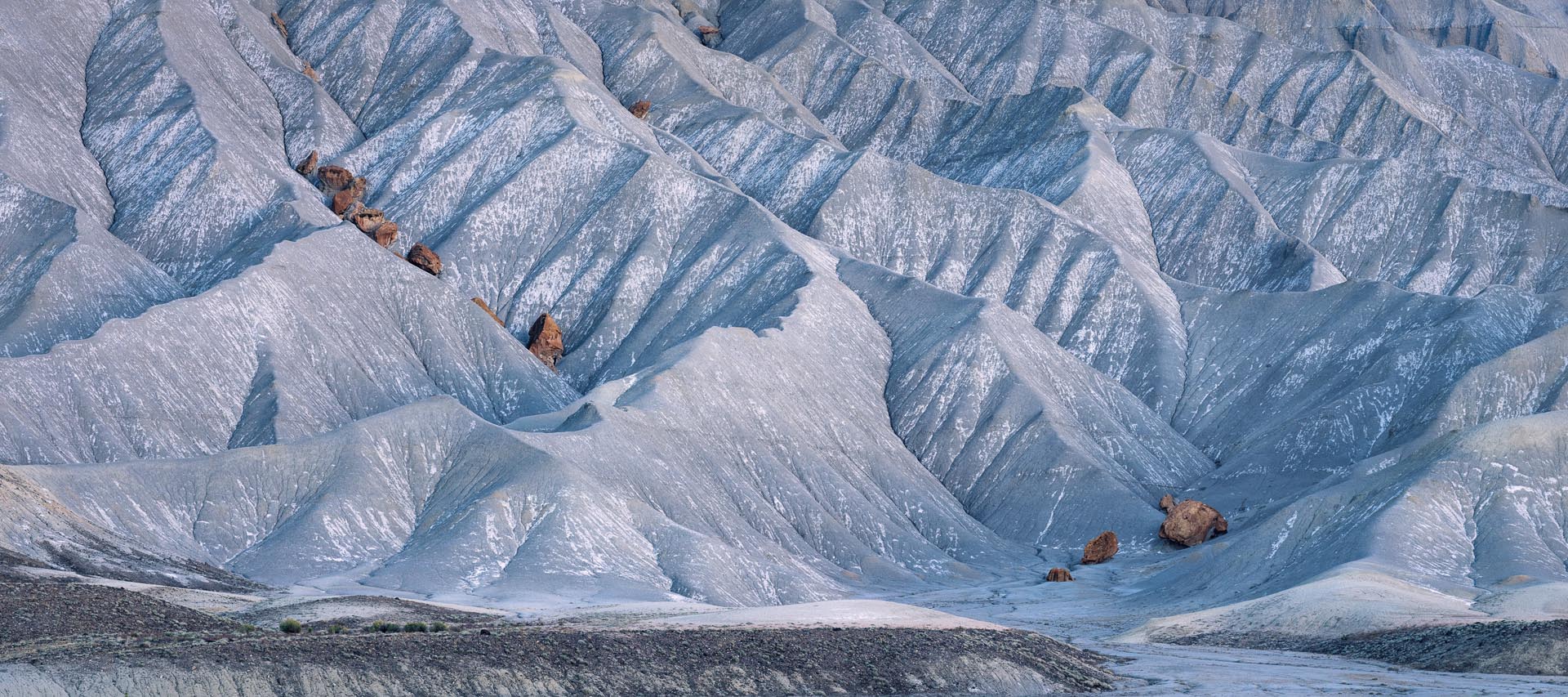
The 200mm lens compresses South Cainville Mesa's foothills into a study of subtle tones and textures. Cool bluish-gray dominates the eroded hillsides, with carefully placed rust-colored boulders providing both balance and scale to the composition.
The panoramic format emphasizes the repeating erosion patterns, while clean edges free of distracting elements keep attention on the graceful flow of the geological forms. A darker foreground anchors the composition, with a subtle opening that provides an entry point into the scene.
10. Chinle Formation and Cottonwoods at Dusk
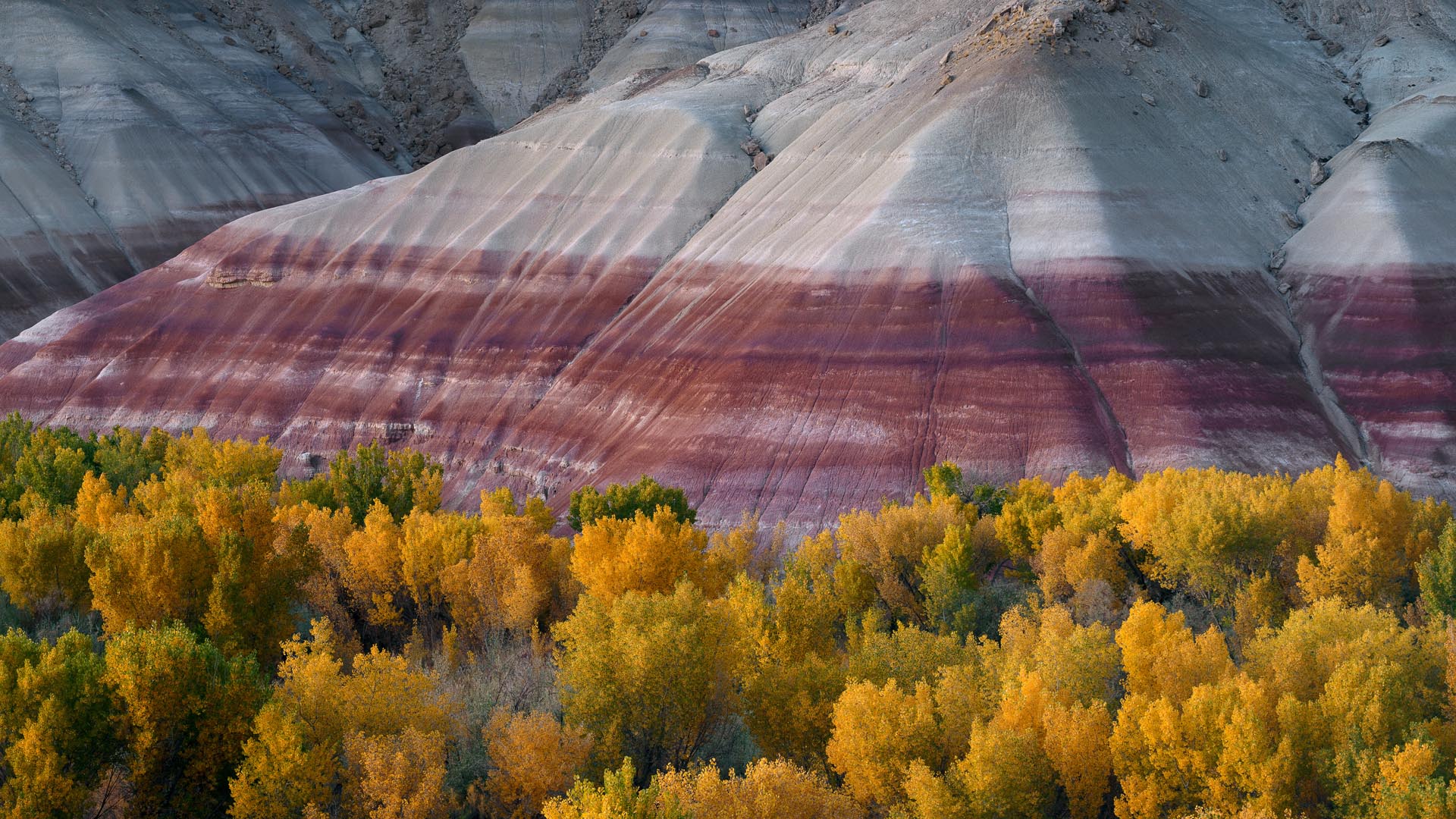
The telephoto lens compresses the scene, bringing together the eroded slopes of the Chinle Formation and the autumn cottonwoods below. The formation's distinctive bands of red and gray fill the upper portion of the frame, while a grove of cottonwood trees in peak fall color creates a luminous band across the bottom. Dusk light enhances the formation's reddish-purple hues while reflected light illuminates the trees' brilliant yellow foliage.
Closing Thoughts on Photographing Capitol Reef National Park and Utah's Badlands
Capitol Reef National Park and Utah's Badlands offer unique photographic opportunities due to the interplay of reflected light in the canyon environment. The towering walls and deep canyons create an abundance of reflected light throughout the day, revealing subtle details and colors in shaded areas.
Hunter Page's workshop provided access to lesser-known locations while demonstrating how reflected canyon light can transform seemingly ordinary scenes. The workshop format offered dedicated time to explore different approaches with both camera systems - from technical movements with the Arca-Swiss to the versatility of the GFX system. Workshops like this provide valuable opportunities to explore new locations with experienced guides while practicing and refining photographic technique in the field.

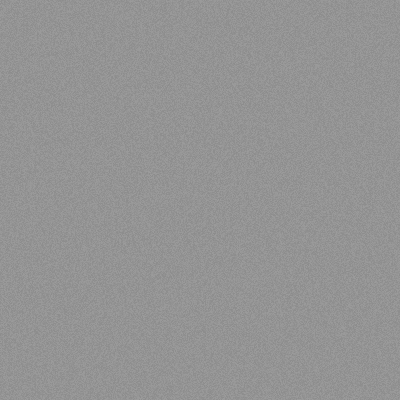 Fashion Gray
Fashion Gray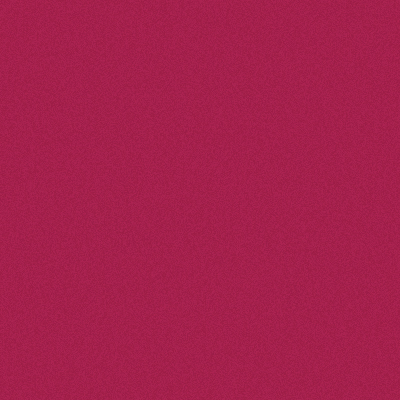 Crimson
Crimson Deep Yellow
Deep Yellow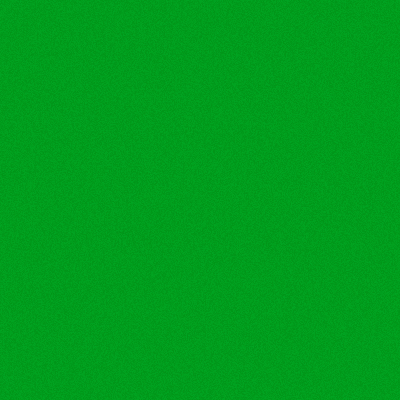 Tech Green
Tech Green Black
Black Purple
Purple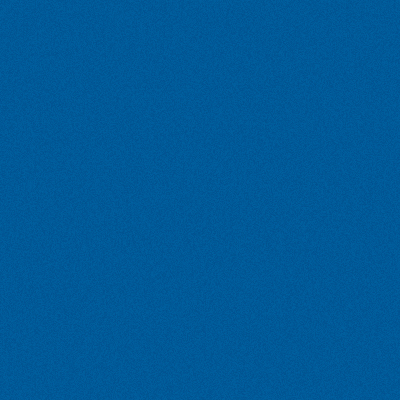 Blue Jean
Blue Jean Blue Jay
Blue Jay Orange
Orange Primary Red
Primary Red Super White
Super White